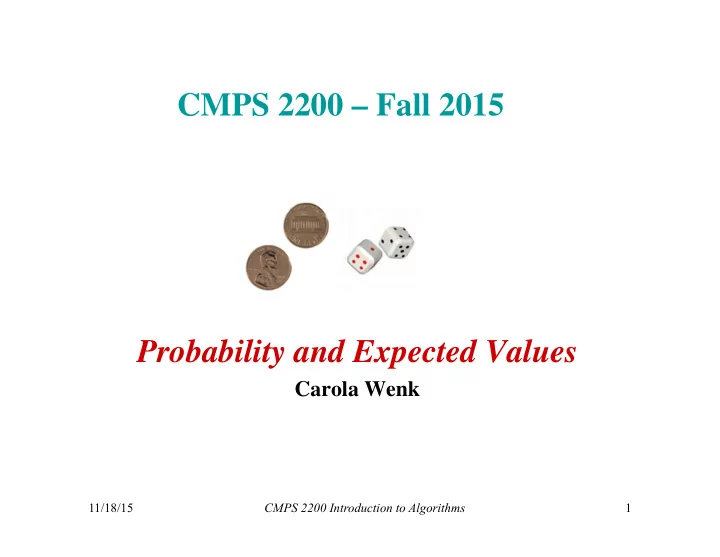

CMPS 2200 – Fall 2015 Probability and Expected Values Carola Wenk 11/18/15 CMPS 2200 Introduction to Algorithms 1
Probability • Let S be a sample space of possible outcomes. E S is an event • • The (Laplacian) probability of E is defined as P( E )=| E |/| S | P( s )=1/| S | for all s S Note: This is a special case of a probability distribution. In general P( s ) can be quite arbitrary. For a loaded die the probabilities could be for example P(6)=1/2 and P(1)=P(2)=P(3)=P(4)=P(5)=1/10. Example: Rolling a (six-sided) die • S = {1,2,3,4,5,6} • P(2) = P({2}) = 1/| S | = 1/6 Let E = {2,6} P( E ) = 2/6 = 1/3 = P(rolling a 2 or a 6) • In general: For any s S and any E S 0 P( s ) 1 • P( s ) = 1 • s S P( E ) = P( s ) • s E 11/18/15 CMPS 2200 Introduction to Algorithms 2
Random Variable • A random variable X on S is a function from S to R X : S → R Head Tail Head Example 1: Flip coin three times. • S = {HHH, HHT, HTH, HTT, THH, THT, TTH, TTT} • Let X( s ) = # heads in s X (HHH) = 3 X (HHT)= X (HTH)= X (THH) = 2 X (TTH)= X (THT)= X (HTH) = 1 X (TTT) = 0 Example 2: Play game: Win $5 when getting HHH, pay $1 otherwise • Let Y ( s ) be the win/loss for the outcome s Y (HHH) = 5 Y (HHT) = Y (HTH) = … = -1 What is the average win/loss? 11/18/15 CMPS 2200 Introduction to Algorithms 3
Expected Value • The expected value of a random variable X: S → R is defined as E( X ) = P( s ) X ( s ) = P({ X = x }) x Notice the similarity to the s S x R arithmetic mean ( or average) . Example 2 (continued): E(Y) = P( s ) Y ( s ) = P(HHH) 5 + P(s) (-1) = 1/2 3 5 + 7 1/2 3 (-1) • s S s S\{HHH} = (5-7)/2 3 = -2/8 = -1/4 = P({ Y = y }) y = P (HHH) 5 + P(HHT) (-1) + P(HTH) (-1) + P(HTT) x R (-1) + P(THH) (-1) + P(THT) (-1) + P(TTH) (-1) + P(TTT) (-1) The average win/loss is E( Y ) = -1/4 Theorem (Linearity of Expectation): Let X,Y be two random variables on S . Then the following holds: E( X + Y ) = E( X ) + E( Y ) Proof: E( X + Y ) = P( s ) ( X ( s )+ Y ( s )) = P( s ) X ( s ) + P( s ) Y ( s ) = E(X) + E(Y) s S s S s S 11/18/15 CMPS 2200 Introduction to Algorithms 4
Randomized algorithms • Allow random choices during the algorithm • Sample space S = {all sequences of random choices} • The runtime T: S → R is a random variable. The runtime T ( s ) depends on the particular sequence s of random choices. Consider the expected runtime E( T ) 11/18/15 CMPS 2200 Introduction to Algorithms 5
Recommend
More recommend